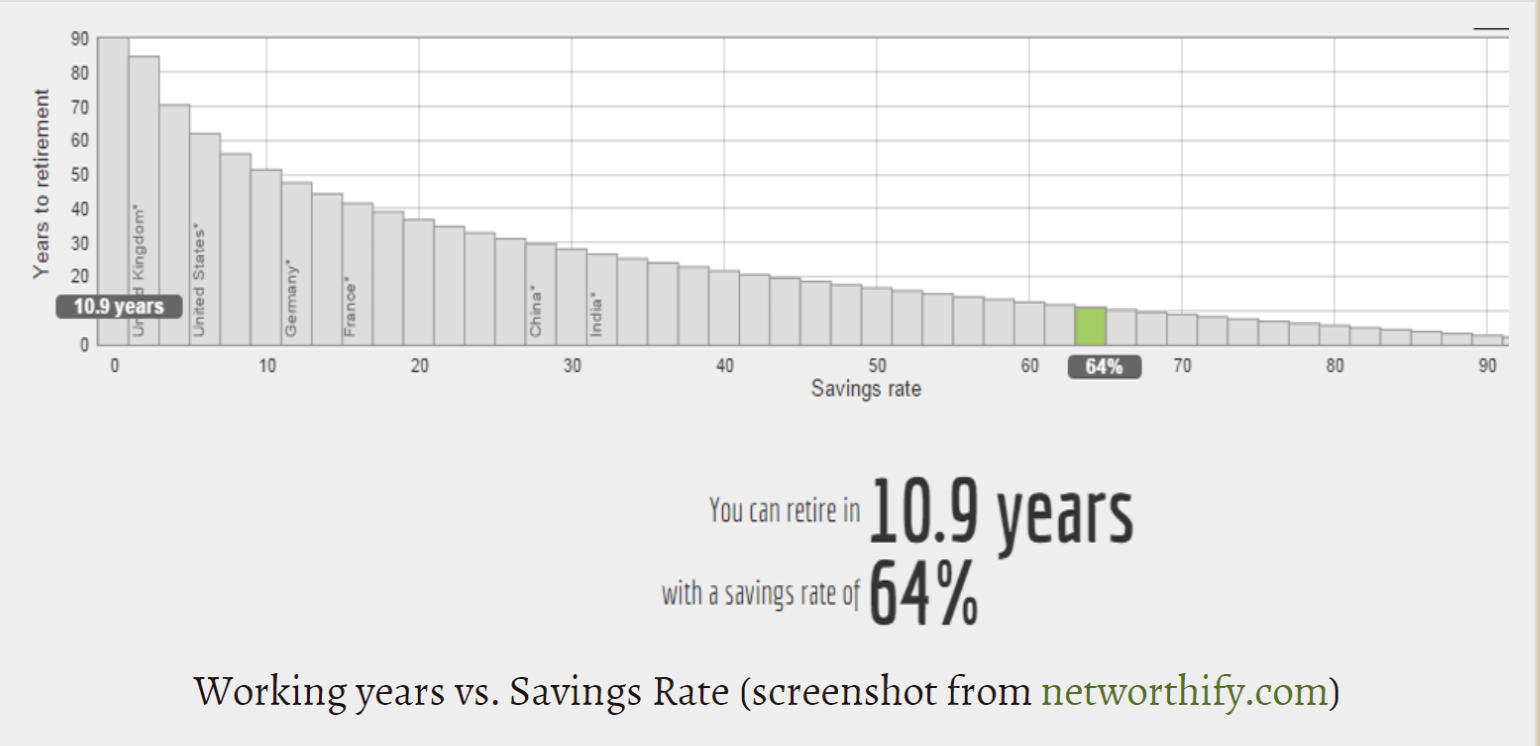Building wealth (Pt 2): Spend less and invest the rest
Building wealth requires that you spend less so that you have money left over to invest. Otherwise, you will likely work for the rest of your life.
If you don’t find a way to make money while you sleep, you will work until you die.
(Warren Buffett)
I assume that for most people looking at their personal finances feels like looking at a Jackson Pollock painting, a big swirly, inscrutable mess that threatens to engulf them if they come too close. (Exhibit 1) Each dot represents a purchase. Multiple dots (or strings of purchases) create unruly lines. This noisy backdrop of daily consumption is punctuated by large, sporadic purchases (e.g., car, computers, home) that further convolute the picture. How does one begin to make sense of these many mundane financial decisions, much less build wealth? As with many things in life, the formula for building wealth is simple. The discipline required to build wealth is hard. With that said, let me first highlight the formula for building wealth.
Exhibit 1: Autumn Rhythm by Jackson Pollock

Know yourself.
As trite as this Greek maxim seems, it still holds as true today as it did in ancient times. If you don’t know who you are, you won’t know where you’re going and, more importantly, why you want to get there in the first place. Wealth is a resource that can be built to help power you to your destination. But, the journey is often long and, thus, requires clarity and conviction to stay the course. If your goal is financial independence, but you’re not sure for what end, then you’re more vulnerable to distraction, derailment and/or discouragement en route. Here’s a list of questions that I ask prospects to answer to help them gain more clarity on why they want to embark on the long and often arduous journey towards financial independence:
· What were your earliest money memories and how have they influenced your actions as an adult?
· What kind of life do you want to live? What role do you see money playing in that?
· What has prompted you to seek out financial advice at this point in your life?
· What are you looking for in a financial planner?
· What does success look like for you?
The purpose of this exercise is to help people reflect on their past, to better understand their present and to gain more clarity around what and why they want to create a certain future. As often the case, without doing the necessary inner work, it’s difficult, if not impossible, to do the outer work.
Know your money.
People typically have a good sense of their earnings, but less so their spending. Oftentimes, many underestimate their spending, which can easily lead to debt: credit cards, student loans, car, mortgage. Debt impedes wealth building like no other! Imagine running a marathon with a 20 lb ball chained to your leg for years, if not decades?!?!? To preempt or address this issue, it’s critical to get more visibility into your cash flow: how much is coming in and how much is going out? Here are some ways to get that visibility:
· Leverage free financial tracking software, such as Personal Capital or Mint.
· Put as many of your expenses on a credit card as possible and then pay off monthly balances in full. Export the inventory of expenses into a spreadsheet on a monthly, quarterly, semi-annual or annual to analyze your spending.
· Track expenses via a spreadsheet.
Personally, I use Personal Capital to track my finances. It’s secure, accurate (mostly), effortless and free. However, regardless of how you want to track your money, it’s important that you have a “system” for doing so. Otherwise, you will inevitably find yourself buried in countless, daily transactions that will hinder your efforts for financial clarity and, thus, progress.
Next, it’s important that you live within your means; your spending is below your earnings. Only by saving money will you create the opportunity to invest (or put it to work for you). Otherwise, you consign yourself to a life wherein you’re always working for money rather than positioning your money to work for you. Below is graph that outlines the relationship between savings rate and working years. If you’re able to save 64% of your gross income, you can retire in 10.9 years. While money can buy you a lot of stuff, the greatest gift it can buy you is probably time and freedom. If you value your time and freedom, then it’s critical that you have a better sense of your (target) saving rate.

Give yourself and your money work.
While your goal(s) determine how much to save, it’s also important to know where to save to make the most of your money. Here are the key savings buckets:
Emergency Fund: While retirement accounts (e.g., 401k, Traditional IRA, Roth IRA) get a lot more air time, it’s the humble emergency fund that allows you to invest and stay invested for the long-term. It helps keep you from being forced to dip into credit cards, home equity line of credit, retirement accounts and other high interests loans, to address (financial) emergencies. How much to keep in an emergency fund? My advice: Keep it simple by setting aside 9-12 months’ worth of living expenses in a high-yield online savings account.
Once you’ve set aside an adequate emergency fund to address the various short-term life emergencies, then it’s time to make real money by investing your savings in the market (or businesses). There are a number of different accounts available. However, for the typical W-2 worker, here’s the strategy/order for which you should consider investing for financial independence or retirement:
A. Tax-deductible or tax-deferred accounts (401k, 403b, Traditional IRA, 457): Consider maxing out your workplace, tax-deferred retirement account by automating your investments per your pay period. You will get instant returns: income tax savings; gains grow tax-deferred so you won’t have to pay taxes until you withdrawal savings; potential employer match.
B. Tax-free accounts (Roth IRA, Roth 401k, Roth 403b): Next, consider maxing out your Roth IRA. While contributions are not tax-deductible, a Roth IRA is a tax-free account. So, you don’t have to pay income taxes on the principal and gains when you withdraw it.
C. Taxable account (brokerage account): Most people don’t think of a brokerage account as a retirement account. However, the higher your tax bracket and the earlier you want to be financially independent or retire, the more useful/powerful it is. Unlike typical retirement accounts, a brokerage account offers a great deal of flexibility:
· There’s no annual contribution limit.
· You can invest or withdraw from it any time.
· Oftentimes, you pay taxes when you sell investment holdings.
· If you hold investments for more than a year, gains will be taxed at capital gains rate (max: 20%), which is far lower than ordinary incometax rate (max: 37%).
By investing your savings, you’re essentially building a “worker” that’s made of money, but has the capacity to work 24/7. So, a little goes a long way thanks to compounding.
Conclusion
Building lasting wealth requires knowing yourself, knowing your money and then making the most of it. While the formula is simple, the discipline required to stay the course is hard. Still, I sometimes suspect that we can overthink it and, thus, make it more difficult than it should be. In my mind, building wealth is like gardening.
· Pick good locations that get lots of sunshine. (Choose the appropriate retirement/investment accounts in which to save.)
· Plant vegetables that support a healthy diet. (Create a diversified portfolio/asset allocation that aligns with your investment horizon, risk tolerance and goals.)
· Water and occasionally weed to support growth. (Dollar-cost average additional money into your portfolio. Occasionally, rebalance to ensure that your portfolio/asset allocation aligns with your investment horizon, risk tolerance and goals.)
· Harvest strategically to make the most of your bounty. (Have a tax-efficient income withdrawal strategy to stretch your savings.)
Know your part. Do your part. Nature/the market will do the rest.
RECENT POSTS
March 2025
Although 2024 double-digit stock market return suggests a strong US economy, the recent change in government leadership and policies highlights the underlying risk (uncertainty) that now weighs down the market and tests American exceptionalism.
December 2024
The fifth anniversary of my advisory firm and the holiday season have prompted me to reflect on my Life’s journey so far and, in so doing, unexpectedly arrive at an unconventional perspective on gifting.
October 2024
August steep market decline serves as a useful dress rehearsal for how we might react in a bear market and what we should do now to increase survival.
Get a free financial education.
Learn more about key financial topics, such as investing, 401k, disability insurance, paying for a home, at your own convenience. Sign up for Women’s Wealth monthly newsletter and have relevant information delivered to your inbox.

Live life on your own terms.
Do you find yourself constantly stressed or bored at work and wondering when you can live life on your own terms? Learn how to harness money’s energy and begin to create your life rather than manage it.
CONNECT
Anh Thu Tran
Women’s Wealth LLC
P.O. Box 1522
Tacoma, WA 98401
anhthu@womenswealthllc.com
(206) 499-1330
Women’s Wealth LLC is a Washington State registered investment advisor. The presence of this website on the Internet shall not be directly or indirectly interpreted as a solicitation of investment advisory services to persons of another jurisdiction unless otherwise permitted by statute. Follow-up or individualized responses to consumers in a particular state by our firm in the rendering of personalized investment advice for compensation shall not be made without our first complying with jurisdiction requirements or pursuant an applicable state exemption. For information concerning the status or disciplinary history of a broker-dealer, investment advisor, or their representatives, a consumer should contact their state securities administrator.
© 2021 Women’s Wealth LLC. All rights reserved. | Design by Erin Morton Creative, LLC.



